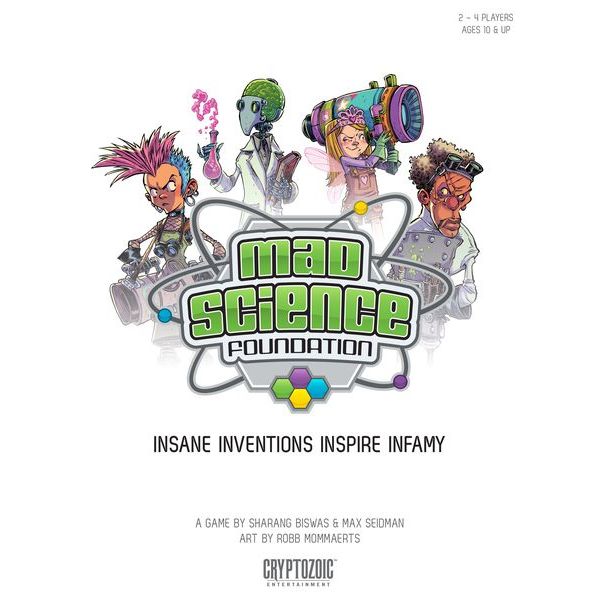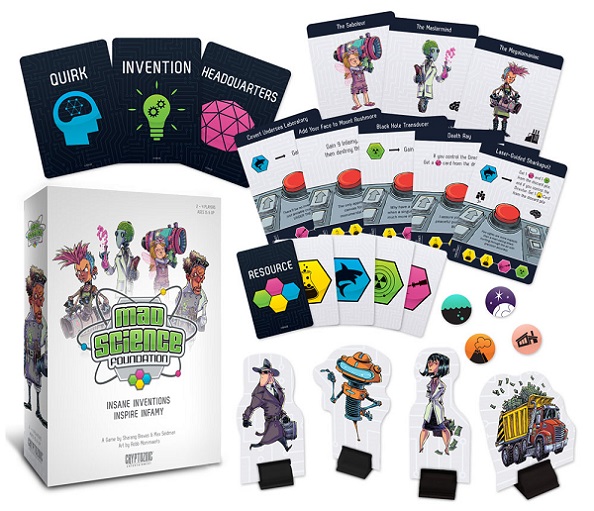Be a Quirky Scientist and Gather Minions in Mad Science Foundation

Time to tap into your inner evil genius as you vie for inventions, minions, and precious supplies that will bring your ideas to life.
Cryptozoic’s Mad Science Foundation will have you making some tough calls, as the director divides the resources and the other players choose them.
Gameplay
Each player starts the game by being dealt a headquarters card and a quirk. Quirks are kept secret and get you an extra bonus or points at the end of the game if you follow their instructions. Headquarters are your first invention. They start out unbuilt and you don’t need to build them during the game if you don’t wish to.
When the game starts, players take turns being the director. The director draws one invention card and resource cards equal to the number of players, plus one. The director then chooses how to divide these cards, creating one pile for each player. If the director ever draws a minion card, he takes the minion’s standee, and from here on out that minion will be included in the piles that are created each round. One of the minion cards is the director — once it is drawn, the director role goes with the pile it is placed in rather than players taking turns one at a time. When a minion card is drawn, the director draws an extra resource card.
Once the director has finished dividing the cards into piles, the other players all take turns choosing one pile, with the director taking the pile that is left.
When you get an invention card, you place it face up in front of you. Inventions always start unbuilt, and you must spend the resources listed on the card in order to build it. Each invention can be used once per turn, usually gaining you victory points if you meet certain requirements. Sometimes more resources must be spent in order to activate an invention, and a few inventions are discarded once used.
There are four different types of resources and some resources are rarer than others. There are also five minions. Each minion has a unique ability that you can use on a turn that you control it (but remember, who controls each minion changes each round based on the piles the director creates). For example, one minion acts as a substitute for any resource of your choice; another allows you to stop a player from activating a specific invention.
Once the invention deck runs out, the game ends. Players check for any extra victory points earned through their quirk cards and then the player with the most points wins the game.

Review
The player interaction in Mad Science Foundation is extensive and excellent. Dividing cards into groups for other players to choose from poses fascinating challenges, especially since you can see exactly what cards your opponents need and they can see exactly what cards you need. You always have to take risks, hoping that you can afford to let an opponent have a useful card so that you can get something you’re after. And sometimes, when players don’t choose as you expect them to, you need to be ready to alter your strategy.
Once the minions start coming out, and they’re added to the list of things being divvied up each round, things get even more interesting. There are a lot of layers to consider each round. If you have a group that tends to agonize over each decision too long and the game drags on, the rulebook offers suggestions for shortening the game (a nice bonus feature).
There’s also a fun, quirky sense of humor in the game, from the theme and flavor text on the invention cards to the fun little jokes peppered throughout the rulebook. However, the artwork on the resource cards and especially the inventions is a little bland and unexciting. It feels like an opportunity has been missed by not actually drawing the inventions. Wouldn’t you rather see a Laser-guided Sharkapult, than just see the big red button to activate it?
As you build more and more inventions, some of them combo off of each other nicely and it’s neat to build up a collection of them and watch the points mount. If you like the core concept at the heart of Mad Science Foundation, one person creating the choices and the others choosing, this is a really good implementation of it. A clever card game and one we enjoyed our time with.
Pros: Fun sense of humor, ability to adjust game length, lots of strategy to be considered when picking sets or dividing cards into sets
Cons: The artwork is lacking
Disclosure: we received a complimentary review copy of this game.






